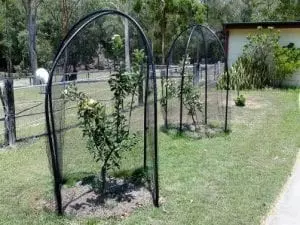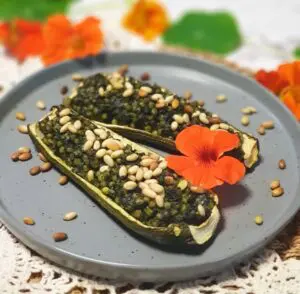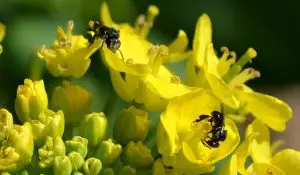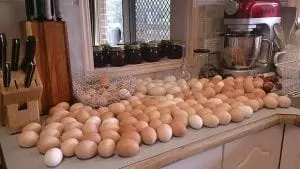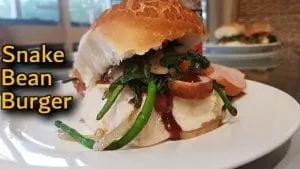My Thai Red Chilli Paste can be used as a flavour base for laksas, soups, curries, noodles, and to add some extra bite to stir-fries.
This summer I had a bumper crop of chillies and they are still going strong even as winter approaches. An abundance of chillies is a good thing because they are so easy keep and use for later. Chillies can be dried, pickled, made into sauce, or left on the kitchen bench for an extended period of use. 
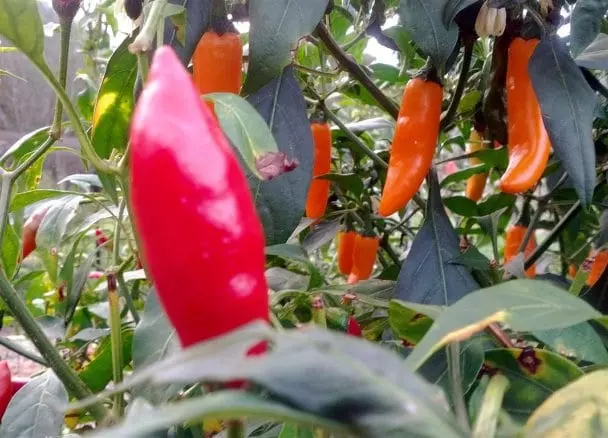
In this recipe, I'm going to describe how I make my Thai red chilli paste. Most of the ingredients in this recipe have been harvested from my own backyard and I know the produce is fresh, with no added chemicals, and pesticide free. Seasonal timing means I can't grow some of the main food items in my paste all year round like limes, chillies, coriander, and ginger; therefore, I prefer to make a batch of paste and freeze it for use as required.
Having some frozen preserved Thai red chilli paste on hand is a very convenient and time-saving way to make a gourmet home cooked meal. Making a Thai chilli paste from scratch can be an obstacle when a busy person just wants a quick no bother meal. However, when the Thai chilli paste is already made (cooked-off) and ready in the freezer it's a cinch to get an Asian style meal going in the kitchen.
Cheaper too! If a person was to buy a similar style paste from the supermarket or speciality store, they could easily pay $5 or more for a small jar where the home-made option has far more cost savings and other benefits.
Which chilli to use?
When it comes to which chillies to use, I would rather encourage people to use personal choice than tell others a certain variety needs to be used – not everyone likes a hot chilli. Also, some varieties  may grow better in different areas and having a licence to use what's growing easy in the backyard makes more sense to me. There are several varieties of Thai chilli as it is, and many other chillies have similar tastes especially when broken down into a paste, therefore, I'd use what you got handy or what's easy to grow in your area.
may grow better in different areas and having a licence to use what's growing easy in the backyard makes more sense to me. There are several varieties of Thai chilli as it is, and many other chillies have similar tastes especially when broken down into a paste, therefore, I'd use what you got handy or what's easy to grow in your area.
Also, Thai chillies do not necessarily need to be used because not even the local Thai people always cook with authentic Thai chillies. I've seen cooking shows in Thailand with chefs using all sorts of chillies. When I was working overseas with some Thai soldiers in the late 90's, they cooked with whatever chillies they could find without once whining about needing a special chilli variety. The food those Thai soldiers cooked during that operation was unforgettably good and it sure beat our ration packs (even if we weren’t always sure what type of meat was in the stir-fry…).
Besides the Thai chilli varieties, other types are great to use and grow like: Cayenne, Serrano, Hungarian, and Tabasco, These varieties are mostly medium to hot in heat and when used correctly add immense flavour to food.
One variety of chilli I would say isn't suitable for this recipe is the Jalapeno because it seems to have a more unique taste closer to a “regular” capsicum, so I'd leave that variety to Mexican cooking. Plus, the heat factor is pretty low for most Jalapenos but they can sometimes get hot depending on slight species variations or just how they are grown.
And then you have the really hot buggers with new varieties popping up everywhere claiming to be hotter than the last holding names like Fatal, Ghost, and Trinidad Scorpion – I would suggest not using these types of chillies in this recipe… don't even think about it.
Of course, some Thai food purists will object strongly to my view on what chillies to use but for those of us with an imperfect palette most chillies will produce terrific culinary results with this recipe.
My Thai Red Chilli Paste (frozen cubes) Ingredients

The following ingredients are what I use for my base chilli paste and it will make 30-40 standard frozen cubes:
-
Chilli – Thai Birds eye chillies and Yellow Cayenne (is what I used this time) about 130.

-
Lemon Grass – 3 x stalks (bottom third of the plant – finely chopped)
-
Limes – Juice and rind x 3
-
Ginger – Medium sized rhizome or ¾ cup (freshly grated)
-
Kaffir lime leaves – ¼ cup (finely chopped)
-
Garlic – 1 x tble spoon of crushed garlic
-
Cardamom – 1 x teaspoon
-
Coriander seed whole (fresh green is best but dry is fine) – 1 x tble spoon
-
Sugar – 4 tble spoons (add more to taste)
-
Salt – 1 ¼ teaspoon
-
Peanut oil – 2 tble spoons
-
Canola oil – 2 tble spoons
-
Water – 1 x cup
Method
Mixing these ingredients together and cooking them off isn't difficult. If your quantities of each ingredient aren’t exact there's no reason to fret as the overall taste shouldn't change too much.
Keep in mind, this is a paste to be used later as a tool or key flavour ingredient for cooking it's not the end pro duct. So what I'm alluding to, is if you have trouble getting the taste exactly right in the end don't worry too much as further taste refining to whatever dish being cooked later can be made.
duct. So what I'm alluding to, is if you have trouble getting the taste exactly right in the end don't worry too much as further taste refining to whatever dish being cooked later can be made.
Having said that, taste as you go to get the flavour just right – there should be a balance of flavour with hints of the ingredients coming through. This recipe produces a medium to hot paste and unless really mild chillies are used, the heat will always be there; however, if the paste tastes too sour balance it with some more sugar by adding small amounts at a time and re-tasting. Similarly, if the paste is too sweet for your liking add some more lime juice or rind.
Seasoning is important also, so add more salt (only a pinch at a time) if the taste is a little bland. The salt and sugar in this recipe helps preserve the paste as well as balancing taste.
No spice should be the hero in this paste; nevertheless, if you can't taste any hint of one or more of the herbs or spices, just chop and add a little more of that spice but don't overdo it.
Below are the steps to making my Thai red chilli paste:
-
De-seed the chillies as best you can (the odd seed left in the paste won't matter) I use kitchen shears to cut the stalk end off and then a slit up the middle – I find it's faster than a knife. Then, I go through and scrape the seeds out with a teaspoon. After de-seeding, roughly chop the chillies up. To prevent chilli getting on hands, it's a good idea to wear some disposable food gloves or medical gloves when doing this job.
-
Place the peanut and canola oil in a large pan or pot and heat nice and hot.

-
Add all the ingredients except for the water and sugar and fry for about 5 minutes stirring regularly.
-
Add the water and sugar and stir for a few minutes until the sugar dissolves.
-
Remove from the heat and pour the mix into a heatproof blender or food processor and blend into a pulpy liquid (if you don't have a heatproof appliance then just wait for the mix to cool). If the mix doesn't blend well then add a little more water so that it mixes easily as a liquid.
-
Transfer the pulpy liquid mix back to the original pan or pot and continue to simmer over a low heat stirring occasionally until it reduces/breaks down to a thick paste.
-
Turn off the heat, cover and leave cool.
-
Once cool, pour/scrape the paste into a piping bag, or a food bag with a small hole in a corner, and “pipe” into a standard ice-cube tray. Or, if your feeling adventurous use an ice-cube tray with different shapes but just remember if the frozen shapes are different sizes portioning into recipes may be a little harder to estimate – whoopee do, you only live once. Naturally, place the trays in the freezer.
-
Leave overnight, then turn-out the frozen Thai red chilli paste cubes and place them into freezer bags and it's job done!
Storage and use
 The Thai red chilli paste cubes should last at least 12 months in the freezer. And, it's just a matter of retrieving a cube from the freezer when required and popping it into the pot or pan to melt and blend a wonderful array of fused flavours into whatever dish you're creating.
The Thai red chilli paste cubes should last at least 12 months in the freezer. And, it's just a matter of retrieving a cube from the freezer when required and popping it into the pot or pan to melt and blend a wonderful array of fused flavours into whatever dish you're creating.
One standard sized cube (with the recipe and chilli type I used) is what I'd recommend for a dish serving up to four people. If you like a hot laksa then two cubes will give good heat without ruining the dish. For a milder heat or just a hint in a stir-fry use half a cube by either melting the full cube to divide it or by using a solid kitchen knife and some force to cut the frozen cube in half (be careful with this method) then the unused half can be put back into the freezer.

Store frozen chilli paste cubes in the freezer with zip-lock bags (above image)
Prawn Laksa Recipe (feeds four with leftovers)
Here are the ingredients:
-
My Thai red chilli frozen cube – 1 x cube (2 cubes if you like it pretty hot) P.S – Perhaps half a cube for a family meal with kids
-
Onion – 1 x large chopped
-
Carrot – 2 x cups (julienned)
-
Baby corn – 1 x small can
-
Bamboo shoots – 1 x small can
-
Water chestnut – 1 x small can
-
Rainbow silverbeet – 2 x cups roughly chopped (can use any Asian greens or spinach)
-
Coconut milk – 2 x cans (400 ml per can)
-
Palm sugar syrup – 1 x tble spoon (or use the palm sugar cubes, also the syrup dosen't keep too well once opened)
-
Asian salmon sauce – 1 x teaspoon (or use shrimp paste)
-
Fish sauce – 1 x tble spoon
-
Tomato paste – 1 x tble spoon
-
Salt – Season to taste (a pinch should do)
-
Large fresh prawns – 1 kg (Peeled)
-
Rice – 1 x cup (Jasmine)
-
Peanut and Canola oil – 1 x tble spoon of each
Method
Step 1 – In a large pan or wok, fry-off onions in the oils along with the frozen chilli cube. At the same time, cook rice in rice cooker or microwave according to your usual settings (I use a microwave-safe bowl and cover the rice with about 2 inches of water cooking on high for 17 minutes then leave stand for 5 mins).

Step 2 – To the onions, add carrot, baby corn, water chestnuts, and bamboo shoots and stir-fry for about 2 minutes.

Step 3 – Pour in the coconut milk, Palm syrup, Asian salmon sauce, fish sauce, tomato paste, and stir occasionally whilst simmering for 2-3 minutes.
Step 4 – Taste and add salt or a little more of the other "flavour ingredients" (like fish sauce) if required.
Step 5 – Add the prawns and simmer for a further 4 mins or until the prawns are just cooked.
Step 6 – Stir in the silverbeet and ladle over a small helping of rice in Asian bowls.

Conclusion
The whole point of making my Thai red chilli paste is to make life easier. With this method, anyone can have the taste and aroma of Asian cooking every night at home (if they wanted) with out the prep-time and extra mess. Furthermore, this method is a way to preserve a harvest or abundance of produce for later use minimising waste and allowing produce to be enjoyed out of season.
out the prep-time and extra mess. Furthermore, this method is a way to preserve a harvest or abundance of produce for later use minimising waste and allowing produce to be enjoyed out of season.
The chilli paste frozen cube is like a flavour bomb secret weapon giving a lift to a meal and making use of fresh ingredients preserved in time. I encourage everyone to give my Thai red chilli paste frozen cubes recipe a try because it really is a great way to cheat but still get that authentic Asian taste in a home-cooked dinner.
Feel free to use the comment section below and have your say.
Look, and see the Earth through her eyes
Mark Valencia – Editor SSM



